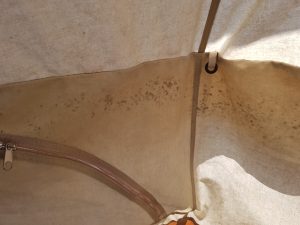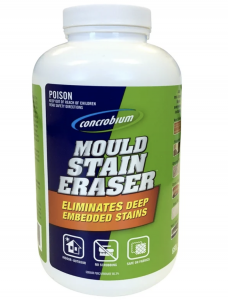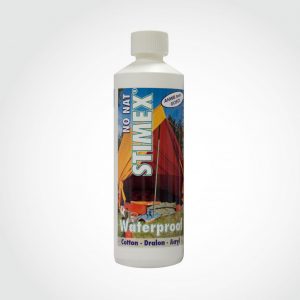We receive a lot of questions regarding mould – mostly about how to prevent it (we love proactive people) or how to get rid of it! We decided to create a blog with all of our mould information in one place as a resource for our customers. Let’s start off with the basics.
What is mould?
Mould is a living organism known as fungi. It is not something that you want growing in your house or on your household items as it can be a health risk. Most people who are healthy will not be affected by the presence of mould, however those who are more sensitive to allergies can find themselves with nasal and sinus congestion, hay fever, sore throats, nasty coughs, headaches, irritations to eyes, body rashes and other aches and pains.
It’s very likely that you’ve seen mould before – either on a slice of bread or in your bathroom. Mould is usually quite easy to get rid of – you can throw out your mouldy bread, and use chemicals to get rid of mould in your bathroom. However when it comes to canvas tents? It can be slightly more tricky to get rid of!
As canvas is a natural material, it means that mould can grow on it if it’s not looked after properly. Mould can eventually rot your canvas and is also associated with respiratory infections, allergies and can worsen asthma. It is extremely important to remove any mould not only to avoid health problems, but also to avoid the cost of replacing your bell tent.
How does it occur and how can you prevent it?
Although all of our tents have been treated to be ‘mould resistant’ it is impossible to make canvas ‘mould proof’, so you do need to look after your tent.
Mould occurs on tents from mainly two scenarios. 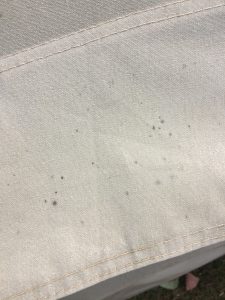
The first one is packing the tent up wet and storing it away for long periods of time without fully drying it. If you must pack it up wet (we know packing up a campsite can be hard!) pull it out when you get home and dry it before storing it away.
Mould can also grow naturally in wet and humid environments. This is sometimes unavoidable, but some care should be taken to have the best chance of fighting the mould. Repositioning the tent so it gets some sun or a chance to dry out, and keeping the windows open during the day to increase airflow can both help prevent mould.
I have mould, now what?
Mould can grow very quickly, so it is essential to deal with it as soon as you notice it.
Our first point of action for people who already have mould is to follow the ‘vinegar method’.
Vinegar method
Materials required
- Stiff bristle brush
- Vacuum
- Vinegar mixture: one-part white vinegar to ten-parts water
- Soft rag, soft broom or brush
Instructions
- Set up your bell tent or hang it by the attached loop at the top, preferably in the sun. Open the window flaps and door for maximum ventilation. Leave the bell tent out to completely dry the canvas. This may take hours or days.
- When the tent is completely dry, brush the mould spores off the canvas with a stiff bristle brush.
- Vacuum the canvas to remove any remaining spores.
- Kill the mould with a mixture of one-part white vinegar to ten-parts water.
- Apply the above solution with a soft rag, soft broom or brush.
- Allow the canvas to dry completely before packing up.
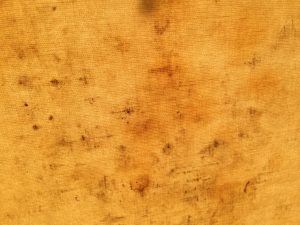 We have found this is the best and least harmful way to get rid of mould! If this doesn’t work you can also try a mix of rubbing alcohol and water (equal parts) and rub the canvas with that mixture. Just be sure not to use too much alcohol so it doesn’t damage the canvas. This method will kill the mould and stop it from spreading, but it won’t always get rid of the stains.
We have found this is the best and least harmful way to get rid of mould! If this doesn’t work you can also try a mix of rubbing alcohol and water (equal parts) and rub the canvas with that mixture. Just be sure not to use too much alcohol so it doesn’t damage the canvas. This method will kill the mould and stop it from spreading, but it won’t always get rid of the stains.
We’ve also heard that lemon, tea tree oil or bi-carb soda can work the same as the vinegar solution! So we recommend trying all of these out (with a bit of elbow grease!) before you try any harsher methods. After trying these methods (including the vinegar method) it’s a good idea to reproof your tent to ensure the waterproof quality of your tent is still intact. We recommend Stimex liquid or spray – depending on how large the area of mould is.
If none of that works?
Well, some people have let the mould on their tent get so bad that the vinegar method or any other ‘natural’ cleaner will not be enough and they need to turn to heavier chemicals to save the tent. We are usually reluctant to suggest this alternative as it can lead to bigger problems down the track, but it can be the only option for some mould!
Please make sure you only resort to chemicals if it is your last option and everything else you have tried fails. You need to be very careful using them because if they are used undiluted and heavy-handed, they can severely damage the canvas – so they need to be used delicately and with care.
A product we recommend would be the ‘Concrobium Mould Stain Eraser’, which is available at most hardware stores. By using heavier chemicals you will remove the mould and stains, but you will affect the waterproofing on the canvas so you will need to reproof the canvas afterwards. Please follow the instructions that come with your product, but if you have any questions please ask us before you start.
Reproofing the canvas
We recommend Stimex products to reproof your tent – and please wait till your canvas is completely dry before you use this! If it is just a small area you need to reproof then you can use the spray, but if it is the whole tent you will need to use the liquid. Although there are other reproof products available, we recommend Stimex as it’s tried and tested by many of our team and customers.
Another product we do recommend is TentMate waterproof and anti-mould spray. TentMate is an Australian made waterproofing and anti-mould treatment, designed for use on new and used tents, awnings, canvas, swags, tarpaulins, caravan annexes and more. Directions for use are as easy as lightly spraying TentMate onto your canvas tent and then rubbing in with a sponge.
We hope that we’ve given you a few different solutions to help either prevent mould on your tent, or remove it if you have been unlucky in preventing it. By taking care of your tent you will be able to enjoy it for years to come – so please be careful when treating your mould!
If you still have questions about any of this, please feel free to contact us! We’re always here to help.




